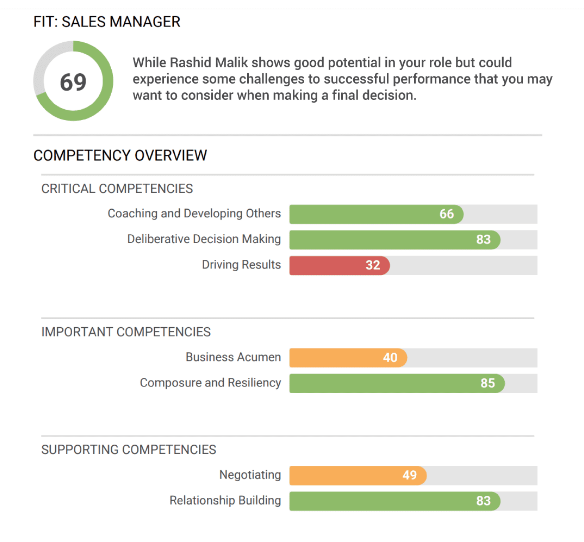You’ve just successfully submitted your application for your dream job. Congrats! Your potential employer now wants you to complete a…pre-employment personality test?
While the thought of a test assessing your personality can be intimidating, it’s really just another way for the potential employer to see if you’d excel in the position.
These tests go beyond your skillset and experience to show what makes you tick, both personally and professionally.
Learn more about pre-employment personality tests below and how to approach the most common types on the market. ResumeSpice editors pick the products and services we write about. When you buy through our links, we may get a commission.
What is a pre-employment personality test?
A pre-employment personality test is a tool that potential employers use to assess candidates’ character traits and behaviors to help determine if they’d be a good fit for the job.
Personality tests look at things like your communication style, motivators, and work preferences. For employers, they provide a better understanding of the job applicant pool so they can reduce employee turnover (and costs!), and offer more consistency in hiring.
Below are six of the most common types of personality tests, including how you can best prepare for each type.
How to prep for a pre-employment personality test
We recommend practicing! Practicing pre-employment assessments is critical to doing your best. The more familiar you are with the test, including its structure, content, and question types, the more comfortable you will be.
How to prepare? Sign up for a service such as Job Test Prep and take one of their pre-employment prep tests.
6 types of personality tests in the workplace
1. Myers-Briggs Type Indicator
How to Prep: Guide for Prepping for the Myers-Briggs Type Indicator
What it is: The Myers-Briggs Type Indicator is a 93-question, self-awareness test that assesses respondents according to four categories or eight tendencies:
- Introversion or extroversion
- Sensing or intuition
- Thinking or feeling
- Judging or perceiving
Each MBTI question comes with two choice statements where you can answer A or B.
The test looks at which tendencies your personality leans more toward (e.g. you’re more introverted than extroverted) to give you a 4-letter personality type such as INFP or ESTJ. There are 16 personality types in all.
MBTI explainer video
Used by more than 88% of Fortune 500 companies, the test is designed to assess your innate personality type preferences and help the employer better understand how you operate.
How to prepare: The Myers-Briggs Type Indicator isn’t your traditional personality test. It tells a potential employer how you’ll fit in with the company team, but isn’t an appropriate indicator if you’re the best fit for the position. Guide for Prepping for the Myers-Briggs Type Indicator
And since there are no right or wrong types, employers can’t use it to compare you with someone else. As such, it’s difficult to prepare for the test. You can, however, become more familiar with the psychological categories so you can better understand your results:
- Extraversion or Introversion (E or I)
- Sensing or Intuition (S or N)
- Thinking or Feeling (T or F)
- Judging or Perceiving (J or P)
Your final personality type tells a good deal about your work style such as how you approach problems, deal with stress, make decisions, and more.
2. Predictive Index Behavioral Assessment
How to Prep: Guide for Prepping for the Predictive Index (PI) Behavioral Assessment
What it is: The Predictive Index Behavioral Assessment is an untimed, free-choice hiring test that helps predict on-the-job success. The test is more than 60 years old and is EFPA-certified.
Here’s how it works: You receive two lists of adjectives. Under the first list, you’ll select words that describe how you believe others expect you to act. Under the second list, you’ll select words that describe how you view yourself.

Adjectives are related to four characteristics (or key behavioral drives) that determine workplace behavior: dominance, extraversion, patience, and formality. At the end of the test, you’ll receive a Reference Profile (there are 17 Reference Profiles in all) that reflects how you approach the world.
How to prepare: The PI Assessment takes between 10-15 minutes to complete. The end result tells a lot about your personality and how you respond to certain situations. Guide for Prepping for the Predictive Index (PI) Behavioral Assessment
Each list comes with 86 adjectives. To help the employer better understand your personality and top characteristics, choose between 20-50 adjectives in each list (hint: don’t choose all 86 as this won’t tell your potential employer anything about you). Adjectives include things like “unbiased,” “friendly,” “forceful,” and “respectable.”
To prepare for the assessment, it also helps to understand the four primary characteristics that the assessment analyzes:
- Dominance. This characteristic (also known as A drive) shows how much you try to control your environment.
- Extraversion. The characteristic (aka B drive) measures how social you are and how much you try to control your environment.
- Patience. This is known as the C drive which measures how much you seek consistency and stability.
- Formality. This characteristic (aka D drive) measures how much you seek to conform to formal rules and structure.

If you want to score low on dominance, you’d select adjectives that show you’re agreeable and accommodating. If you want to score high on patience, you’d choose adjectives related to stability.
Based on your answers, your Reference Profile might show that you’re analytical and fall under being an analyzer or controller. Or it might show that you’re social and act as a captain or maybe a collaborator.
There are no right or wrong answers here, but the assessment does provide interesting personality insights!
3. DiSC Assessment
How to Prep: Guide for Prepping for the DiSC Assessment
What it is: This personal assessment tool analyzes your personality according to four personality traits or DISC factors. It’s used to understand your ability to work with a team and your professional behavior style.
Used by a wide range of organizations including government agencies and Fortune 500 companies, the DiSC assessment can be completed online and includes 12-30 questions. Choose between adjectives or phrases that you relate to the most and the least.
DiSC factors include:
- Dominant (D)
- Influential (I)
- Steady (S)
- Compliant (C)
These factors show employers how you respond to conflict, how you work with teammates if you’re a leader and more. You’ll receive a personality profile at the end of the assessment that shows where you “fit” into the four main personality reference points.
How to prepare: This temperament assessment is about 80 questions long and takes 15-30 minutes to complete. It’s designed to show your strengths based on the DiSc factors. Guide for Prepping for the DiSC Assessment
Since the DiSC assessment is not technically a test, it’s not something you can really prepare for. However, it is helpful to understand what each DisC factor means and how each relates to specific positions:
- Dominant. This factor means that you exhibit dominant tendencies and are focused on results and problem-solving.
- Influential. This factor suggests that you are more open and focus on relationships.
- Steady. S personalities mean that you are dependable and are a collaborative team player.
- Compliant. This factor means that you are focused on things like quality, accuracy, and competency.
Similar to the PI Behavioral Assessment, these factors tell you a lot about your personality and how well you’ll fit in a certain position.
For example, if you lean more toward D (Dominant), you might be better suited for an executive position or an entrepreneurial role. If you lean more toward C (Compliant), an engineer, analyst, or content marketing position could be a good fit, as you prioritize quality and are detail-oriented.
4. The Caliper Profile
How to Prep: Guide for Prepping for the Caliper Test
What it is: The Caliper Profile is an objective assessment that measures 22 character traits to predict on-the-job behaviors and potential.
Based on both cognitive and behavioral aspects of your personality, the assessment includes a mix of true/false questions, multiple-choice, and statements. For example, with the Caliper Profile statements, choose answers that reflect you the most or least.
Sample statements include things like “I am an effective negotiator” and “I always plan my expenses in advance.”
Once you’ve completed the test, your results are measured against one or more validated job models. The assessment analyzes you by 56 competencies and has 52 job models.

How to prepare: The Caliper Profile test includes 98 questions. There’s no time limit, but it normally takes about an hour to complete. Guide for Prepping for the Caliper Test
To successfully pass the Caliper Profile, become familiar with the types of questions on the test. One large part of the test measures your ability to solve cognitive problems such as recognizing patterns and selecting the next number in a series (some of these questions can be tough).
Take practice tests online and identify any areas where you struggle. Pay extra attention to cognitive questions, but practice answering all types of questions. Get a good night’s sleep before the test and don’t overthink it.
And know that you can’t fail the test. It’s designed to help the employer discover if you’re a match for the job!
5. The SHL Occupational Personality Questionnaire
How to Prep: Guide for Prepping for the SHL Occupational Personality Questionnaire
What it is: Also known as OPQ32, the SHL Occupational Personality Questionnaire describes an individual's preferred or typical behavioral style. It helps an employer decide if your personality will suit the job.
The questionnaire assesses 32 work-related dimensions which are grouped into three categories:
- Relationship with People. Influence, Sociability, and Empathy.
- Thinking Style and Feelings. Analysis, Creativity and Change, and Structure.
- Emotions. Emotion and Dynamism.

Each question includes four statements or adjectives to choose from. Here’s an example of what these statements might look like:
- I really like to help others.
- I work best in teams.
- I like to get things exactly right.
- I sustain high levels of energy.
You’d then select which statement is more or least like you. Results are measured on a consistency scale.
How to prepare: The questionnaire includes 104 questions and takes about 25 minutes to complete. The best way to prepare for the OPQ32 is to simply practice. Take practice tests and become familiar with the types of statements that are listed within the questionnaire. Guide for Prepping for the SHL Occupational Personality Questionnaire
As with the other tests, you can’t fail, but it does help to build your confidence and understand your preliminary results by preparing.
Employers can choose a custom report once you complete the questionnaire and see how you stack up against other applicants.
6. The Hogan Personality Inventory (HPI)
How to Prep: Guide for Prepping for the Hogan Personality Inventory (HPI) Test
What it is: The Hogan Personality Inventory describes “bright-side personality – qualities that describe how we relate to others when we are at our best.” The test tells employers how well you will fit with the job and how you will act in different circumstances.
It’s based on the Five-Factor Model of Personality. This model features a hierarchical organization of personality traits based on five basic dimensions:
- Extraversion
- Agreeableness
- Conscientiousness
- Neuroticism
- Openness to Experience.
Based on these dimensions, the HPI is made up of seven primary scales, six occupational scales, and 42 subscales. Scales include things like “Adjustment,” “Prudence,” and “Ambition.”
How to prepare: The HPI includes 206 true/false questions and takes between 15- to 20-minutes to complete. Here are a few sample questions where you would answer either true or false:
- I love spending time with other people.
- If a friend comes to me looking for help, I do all I can to assist.
- I often feel stressed.
- I find a routine stifling.
- I work very hard toward my goals.
Use practice tests to review sample questions and understand what the results mean for you. Guide for Prepping for the Hogan Personality Inventory (HPI) Test
For example, if you score high on Ambition, this suggests that you are a self-starter, but might be overly competitive. If you score low on Sociability, you might be good at working alone, but might not be as apt to speak in public.
Be honest on your pre-employment personality test
Always be yourself, express yourself, have faith in yourself, do not go out and look for a successful personality and duplicate it. – Bruce Lee
This quote is absolutely true, but it can feel a bit daunting to completely be yourself on any of these pre-employment personality tests.
But if you base answers on what you think the employer will want to hear, the job probably isn’t going to be the best fit over the long term. Honesty really is the best approach.
If you’re looking to make a career change, ResumeSpice is here to help. We offer premium career coaching, resume writing, and cover letter services, LinkedIn profile writing, and more. Please contact us today to learn about our services!






